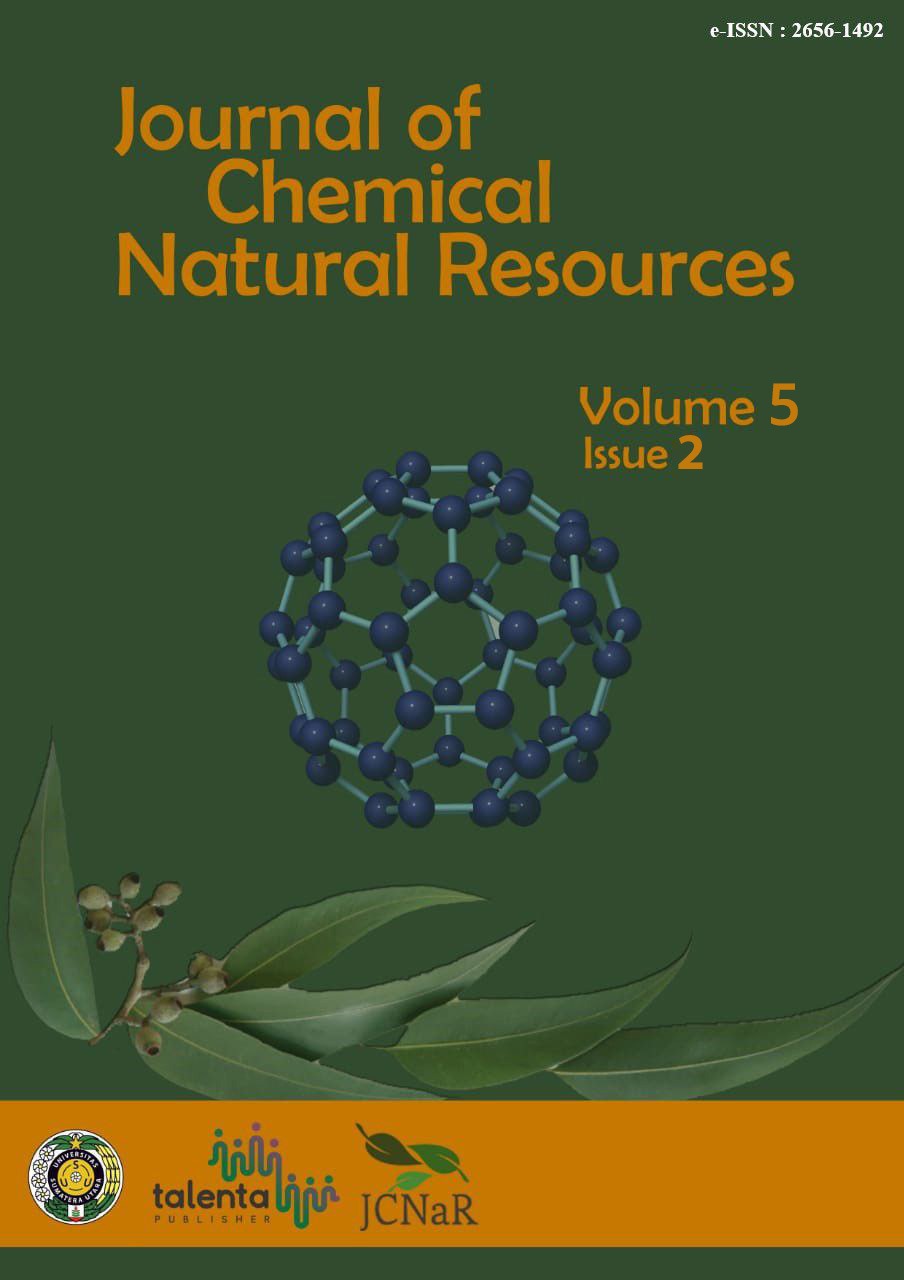Synthesis of Schiff Bases via Condensation of Aldehydes from Ozonolysis of Purple Passion Fruit Seed Oil with Phenylhydrazine and Aniline and Their Utilization as Corrosion Inhibitor on Steel Metal (Zn) in 0.1N HCl Solution Media
DOI:
https://doi.org/10.32734/jcnar.v5i2.13795Keywords:
Aniline, Corrosion Inhibitor, Phenylhydrazine, Purple Passion Fruit Oil, Schiff's BaseAbstract
Schiff base was synthesized through a condensation reaction between the aldehyde derived from purple passion fruit seed oil and phenylhydrazine (Schiff base I) and the aldehyde derived from purple passion fruit seed oil with aniline (Schiff base II). Aldehydes are obtained from the ozonolysis process of purple passion fruit seed oil using ozone to produce ozonides and then reduced with Zn powder in dilute acetic acid. The formation of aldehyde derivatives of purple passion fruit seed oil is supported qualitatively by the formation of a brick red precipitate through the addition of Fehling reagent and the formation of a silver mirror on the wall of the test tube with the addition of Tollens reagent and a decrease in the number of iodine compared to purple passion fruit seed oil and the results of FT-IR analysis provide a spectrum with a vibration peak at a wave number of 1744.4 cm-1 which indicates the C=O aldehyde group. The aldehyde derivative of purple passion fruit seed oil produced has an iodine value of 110.0467, which is lower than that of purple passion fruit seed oil, which is 122.0644. The formation of Schiff II base resulted in yields of 3% and 70% supported by FT-IR spectrum of vibration peaks at wave numbers 1654 cm-1 and 1602.8 cm-1, which indicated the formation of imines (-C=N-) as a result of condensation between derived aldehyde groups of purple passion fruit seed oil with amine groups of phenylhydrazine and aniline. Testing the iodine number on the Schiff I base and the Schiff II base yielded values of 124.9079 and 117.3266. A corrosion inhibitor test was carried out using the gravimetric method on HCl media with a concentration of 0.1N, 24 hours and various concentrations of compounds 1000, 3000, 5000, and 7000 ppm. Corrosion inhibitor efficiency for purple passion fruit seed oil, Schiff Base I, and Schiff Base II, respectively, were 27.87%, 88.28% and 94.08% at a concentration of 7000 ppm.
Downloads
References
A. E. H. Siregar and T. Gultom, “Karakterisasi Morfologi Markisa (Passiflora) di Kabupaten Karo Sumatera Utara,†Pros. Semin. Nas. Biol. dan Pembelajarannya Univ. Negeri Medan, pp. 7–10, 2018.
B. P. Statistik, “Produksi Tanaman Buah-buahan 2020,†Badan Pusat Statistik.
D. P. S. Utara, “Data Pertanian Sumatera Utar,†Dinas Pertanian Sumatera Utara.
R. Fessenden and J.Fessenden, Kimia Organik, Ketiga. Jakarta: Erlangga, 1986.
Z. Cimerman, N. Galic, and B. Bosner, Natural Polymers, Biopolymers, Biomaterials, and Their Composites, Blends, and IPNS. New Jersey: Apple Press, 1997.
A. I. A. Soliman et al., “Base-Free Synthesis and Photophysical Properties of New Schiff Bases Containing Indole Moiety,†ACS Omega, vol. 7, no. 12, pp. 10178–10186, 2022, doi: 10.1021/acsomega.1c06636.
L. Sitepu, “Sintesis Basa Schiff dari Hasil Kondensasi Pati Dialdehid dengan Dietiltriamin Serta Uji aktivitas Antibakteri,†Universitas Sumatera Utara, 2019.
S. Febriany, “Sintesis Basa Schiff Dari Hasil Kondensasi Etilendiamin Dan Anilina Dengan Senyawa Aldehida Hasil Ozonolisis Metil Oleat Serta Pemanfaatannya Sebagai inhibitor Korosi Pada Logam Seng,†Universitas Sumatera Utara, 2014. [Online]. Available: https://123dok.com/document/1y9wwlzg-sintesis-kondensasi-etilendiamin-anilina-aldehida-ozonolisis-pemanfaatannya-inhibitor.html
D. Graiver, R. Dacomba, M. Khawaji, A. Jaros, K. Berglund, and R. Narayan, “Steel-corrosion inhibitors derived from soybean oil,†JAOCS, J. Am. Oil Chem. Soc., vol. 89, no. 10, pp. 1895–1903, 2012, doi: 10.1007/s11746-012-2077-z.
R. Sinulingga, “Sintesis Basa Schiff melalui Reaksi Kondensasi Etilendiamina dengan Aldehida Hasil Ozonolisis Minyak Jarak (Ricinus communis Linn) Dan Pemanfaatannya sebagai Inhibitor Korosi Terhadap Logam Seng,†Univesitas Sumatera Utara, 2014.
L. Stephani, “Sintesis Basa Schiff melalui Kondensasi Aldehida Hasil Ozonolisis Metil Ester Asam Lemak Minyak Kelapa Sawit dengan Anilina dan Fenilhidrazin yang Berfungsi sebagai Antibakteri maupun Inhibitor Korosi pada Logam Seng,†Universitas Sumatera Utara, 2016.
J. Silalahi and M. . Sinaga, “Pra Rancangan Pabrik Pembuatan Asam Lemak dari Biji Markisa (Passiflora edulis) dengan Proses Hidrolisis dengan Kapasitas 1.500 Ton/Tahun dan Tugas Khusus Rancangan Keteknikan Detail Reaktor Hidrolisis,†Universitas Sumatera Utara, 2023. [Online]. Available: https://repositori.usu.ac.id/handle/123456789/88256
E. Raczuk, B. Dmochowska, J. Samaszko-Fiertek, and M. J, “Different Schiff Bases-Structure, Importance and Classification,†Molecules, vol. 27, no. 3, p. 787, 2022, doi: 10.3390/molecules27030787.
M. . Hassan, A. . Omer, E. . Abbas, and W. M. . Baset, “Preparation, physicochemical characterization and antimicrobial activities of novel two phenolic chitosan Schiff base derivatives`,†Sci. Rep., vol. 8, no. 1, p. 11416, 2018.
H. Sihotang and D. Shinta, “Phenilhydrazone from Furfural Results of Corn Isolation and Its Utilization as Corrosion Inhibitor in Zinc (Zn) Metal,†J. Chem. Nat. Resour., vol. 03, no. 01, 2021.
J. Wang, L. An, J. Wang, J. Gu, J. Sun, and X. Wang, “Frontiers and Advances in N-heterocycle Compounds as Corrosion Inhibitors in Acid Medium: Recent advances,†Recent Adv. Adv. Colloid Interface Sci., 2023, doi: 10.1016/j.cis.2023.103031.

Downloads
Published
Issue
Section
License
Copyright (c) 2023 Journal of Chemical Natural Resources

This work is licensed under a Creative Commons Attribution-ShareAlike 4.0 International License.














